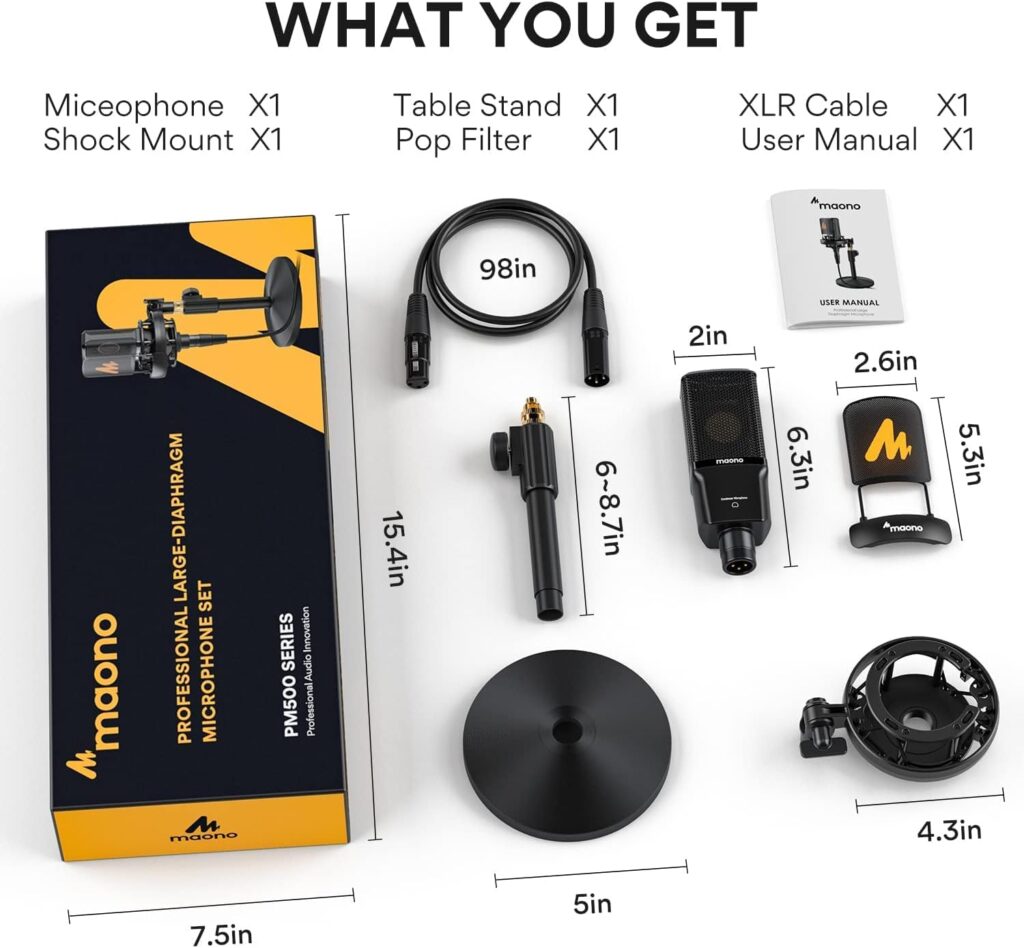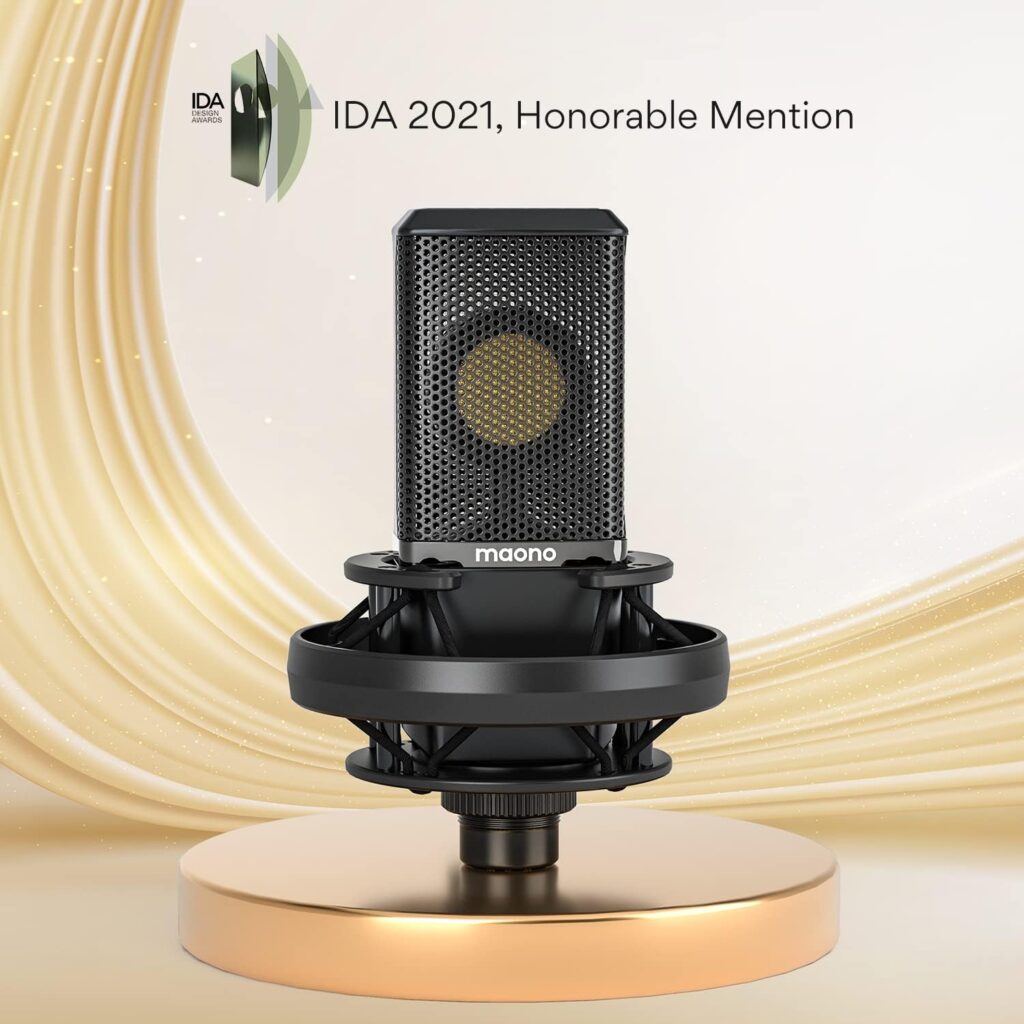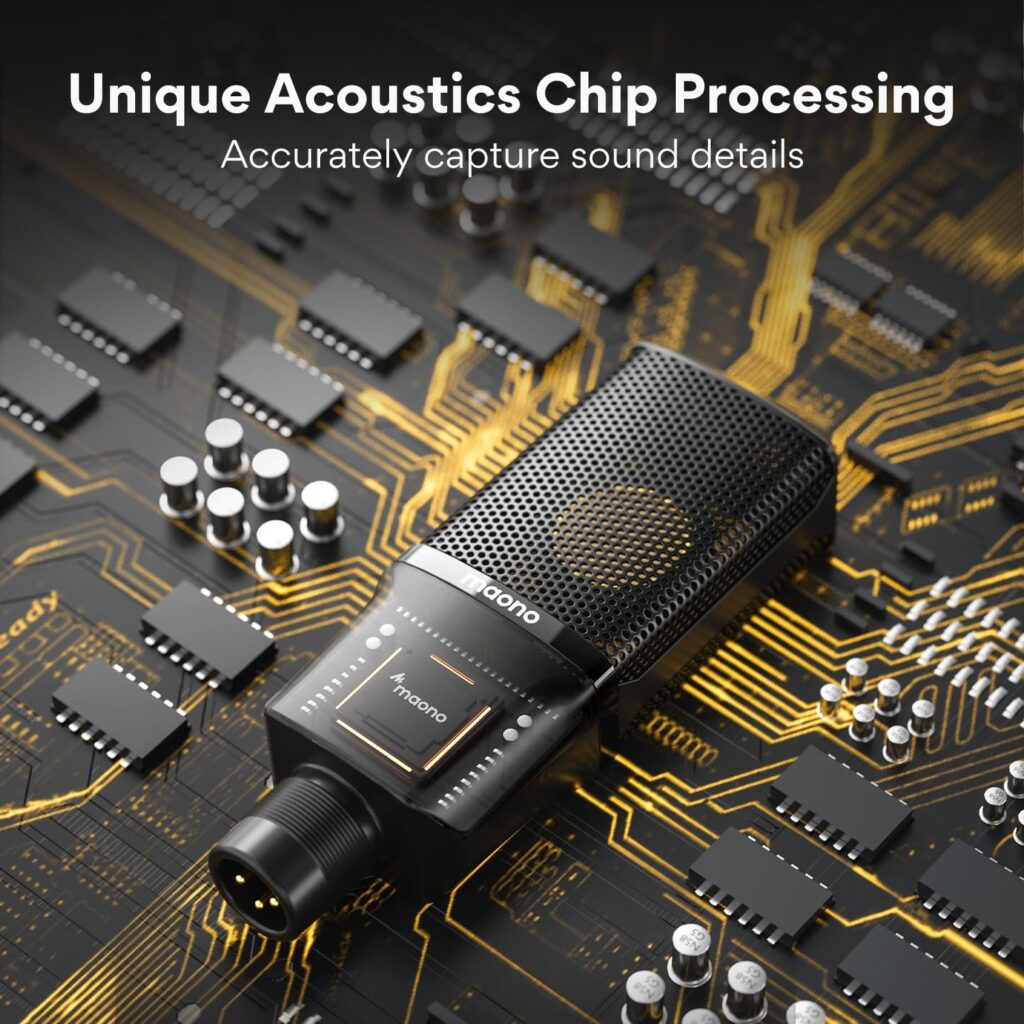Maono PM500 Review
In the ever-evolving world of audio recording, finding a microphone that balances quality, versatility, and affordability can feel like a daunting task. Enter the Maono PM500, a large-diaphragm condenser microphone designed to cater to vocalists, podcasters, streamers, and home studio enthusiasts alike. Priced at around $150, this XLR microphone promises professional-grade performance without breaking the bank. But does it live up to the hype? In this review, we’ll explore every facet of the Maono PM500—from its build quality and accessories to its sound profile and real-world applications—to help you decide if it’s the right tool for your audio needs.
Maono PM500 Review
Maono, a relatively new player in the audio equipment market, has quickly gained attention for delivering high-value products aimed at content creators, particularly younger generations diving into podcasts, streaming, and music production. The PM500 is a flagship offering in their lineup, featuring a custom-designed 34mm gold-sputtered condenser capsule, a cardioid polar pattern, and a robust zinc alloy construction. It’s an XLR microphone, meaning it requires 48V phantom power and an audio interface or mixer to operate, positioning it as a step up from USB microphones in terms of sound quality and flexibility.
Out of the box, the PM500 comes equipped with a shock mount, a metal pop filter, an XLR cable, and, in some kits, an adjustable desktop stand or boom arm. This generous accessory package ensures you have everything you need to start recording right away, assuming you already own an interface. With a frequency response of 20Hz to 20kHz, a maximum SPL of 120 dB, and a signal-to-noise ratio of 70 dB-A, the specs suggest a microphone capable of capturing a wide range of audio with clarity and minimal noise. But specs only tell part of the story—let’s dive into the details.
Design and Build Quality
First impressions matter, and the Maono PM500 doesn’t disappoint. The microphone sports a sleek, minimalist design with a near-rectangular body topped by a metal grille that houses the large diaphragm capsule. Constructed from zinc alloy and treated with multi-layer coatings, it feels sturdy and substantial in hand, weighing in at 369 grams. This durability is a big plus for home studios where equipment might occasionally take a tumble. Maono claims the metal body also acts as an electromagnetic shield, reducing interference and delivering a cleaner audio signal—a thoughtful touch for a microphone in this price range.
The included shock mount is equally impressive. Featuring a ⅝” thread, it’s compatible with most stands and boom arms, and its elastic suspension effectively isolates the microphone from vibrations. The metal pop filter, while not as robust as foam windscreens like the Shure A7WS, does a decent job of reducing plosives and adds to the professional aesthetic. Some kits also include a telescopic desktop stand, which is adjustable in height and angle, offering a stable base for desk-bound creators. Overall, the build quality exceeds expectations for a sub-$200 microphone, rivaling more established brands in terms of feel and finish.
Setup and Compatibility
Setting up the Maono PM500 is straightforward but requires a bit more effort than plug-and-play USB microphones. As an XLR microphone, it needs an external power source—specifically 48V phantom power—provided by an audio interface, mixer, or device like the Rodecaster Pro. The included XLR cable (1.8 meters in some versions) connects the mic to your setup, and from there, it’s a matter of configuring your recording software to recognize the input.
For this review, I tested the PM500 with a Focusrite Scarlett 2i2 interface connected to a Windows laptop running Audacity. After plugging in the cable and enabling phantom power, the microphone was detected instantly, and I was ready to record within minutes. It’s worth noting that if you plan to use the PM500 with a smartphone or tablet, you’ll need an interface or mixer with phantom power compatibility, as the microphone won’t work directly with these devices. This requirement might be a hurdle for beginners, but it’s a small price to pay for the enhanced audio quality XLR offers over USB.
Sound Quality

The heart of any microphone review lies in its sound performance, and the Maono PM500 delivers a compelling case. Its 34mm gold-sputtered condenser capsule—the largest in its class—promises a wide dynamic range and exceptional clarity, while the cardioid polar pattern focuses on sound from the front, minimizing pickup from the sides and rear. With a frequency response of 20Hz to 20kHz, it captures the full spectrum of human hearing, from deep lows to crisp highs.
In practice, the PM500 produces a clean, detailed, and natural sound with a slight warmth that enhances vocal presence. Recording a spoken word sample in a basement with moderate ambient noise, I found the microphone effectively rejected background sounds, thanks to its tight cardioid pattern. The audio was smooth and full-bodied, with a silky top end and a balanced midrange that didn’t require much post-processing. Compared to a USB microphone like the Blue Yeti, the PM500 offered a noticeable improvement in clarity and depth, likely due to its superior capsule and XLR connectivity.
For musical applications, I tested the PM500 on an acoustic guitar, positioning it about 6 inches from the 12th fret, angled slightly away from the soundhole to avoid excessive bass. The result was a rich, creamy tone with pronounced low-mids, though it lacked the airiness of a brighter condenser like the Lewitt LCT 140 Air. This warmth makes it less ideal for capturing the sparkling highs of instruments like cymbals or fingerpicked guitar, but it shines for vocals, rap, and spoken word, where a smooth, broadcast-like quality is desirable.
The microphone’s self-noise, rated at 20µVrms, is slightly higher than premium condensers, but in a typical home environment, it’s negligible unless you’re in a perfectly silent room. The maximum SPL of 120 dB handles loud sources—like a guitar cabinet or shouting vocals—without distortion, though it’s not as robust as dynamic mics designed for extreme volumes. Overall, the sound signature is neutral with a touch of warmth, making it versatile for a range of applications without sounding overly colored.
Features and Specifications
Let’s break down the PM500’s key technical specs:
- Capsule: 34mm gold-sputtered large diaphragm condenser
- Polar Pattern: Cardioid
- Frequency Response: 20Hz – 20kHz
- Sensitivity: -35.3 dBu at 1kHz
- Output Impedance: 98.7 ohms
- Maximum SPL: 120 dB
- Signal-to-Noise Ratio: 70 dB-A
- Power Requirement: 48V phantom power
- Noise Level: 20µVrms
- Dynamic Range: 120 dB
The cardioid pattern excels at off-axis sound rejection, making it ideal for untreated rooms where background noise is a concern. The wide frequency response ensures it captures both the rumble of a deep voice and the nuance of higher-pitched tones. The circuit design incorporates premium components and a permalloy audio signal transformer, which Maono claims reduces self-noise and enhances sound capture—a feature typically found in higher-end models.
One minor critique is the included pop filter. While functional, it’s a metal grille rather than a foam windscreen, which can slightly dampen high frequencies. Pairing it with a third-party windscreen, like the Shure A7WS, can further reduce plosives and improve treble clarity, as noted by some reviewers. However, for its price, the PM500’s feature set is remarkably comprehensive.
Practical Applications
The Maono PM500 is marketed as a studio-grade microphone for vocalists, instrument performers, podcasters, streamers, and audio professionals. Its versatility makes it a strong contender across these domains:
- Podcasting and Streaming: The warm, detailed sound and excellent noise rejection make it a standout choice for spoken word. Whether you’re recording solo or hosting guests, the PM500 delivers a professional tone that rivals mics costing twice as much.
- Vocal Recording: Singers and rappers will appreciate the microphone’s ability to capture subtle nuances without bloating the low end. Its smooth response to dynamic changes minimizes sibilance and resonance, producing ready-to-use tracks.
- Instrument Recording: While best suited for vocals, it performs admirably on acoustic guitars, drums, and percussion, though it may not excel with bright, treble-heavy instruments.
- Voiceovers and Broadcasting: The broadcast-like warmth and clarity lend a polished feel to narrations and live streams, appealing to content creators aiming for a professional edge.
In a home studio setting, the PM500 thrives in quiet or mildly treated spaces. Condenser microphones are inherently sensitive, so pairing it with absorbent surfaces—like rugs or curtains—helps combat echo. For mobile recording, its reliance on phantom power and an interface makes it less portable than USB options, but the trade-off is worth it for the audio quality.
Pros and Cons
Pros:
- Exceptional sound quality for the price—clean, detailed, and warm
- Robust zinc alloy construction with a premium feel
- Comprehensive accessory package (shock mount, pop filter, XLR cable)
- Tight cardioid pattern reduces background noise effectively
- Versatile for vocals, podcasts, and some instruments
- Affordable entry into XLR recording
Cons:
- Requires phantom power and an interface, adding setup complexity
- Included pop filter is decent but not top-tier
- Slightly higher self-noise than premium condensers
- Less ideal for bright or treble-focused instruments
Comparison to Competitors
How does the Maono PM500 stack up against its peers? Compared to the Audio-Technica AT2020 ($99), another popular budget condenser, the PM500 offers a larger diaphragm (34mm vs. 16mm) and a warmer tone, though the AT2020 is crisper and slightly quieter in terms of self-noise. Against the Rode NT1 ($269), the PM500 holds its own in build quality and vocal clarity but falls short in noise performance and treble detail, as expected given the price gap.
For USB microphone users considering an upgrade, the PM500 outshines the Blue Yeti ($129) in depth and signal purity, thanks to its XLR design, though it sacrifices the Yeti’s plug-and-play simplicity. In its price bracket, the PM500’s combination of sound, build, and accessories makes it a standout value proposition.
The Bottom Line
The Maono PM500 is a triumph of value-driven engineering. It’s not perfect—its self-noise and pop filter could be improved, and it’s not the most portable option—but these are minor quibbles in light of its strengths. With a durable build, a rich and natural sound profile, and a wallet-friendly price, it’s an excellent choice for podcasters, streamers, vocalists, and home studio enthusiasts looking to step into the world of XLR recording without a hefty investment.
If you’re ready to trade the simplicity of USB for superior audio quality, the PM500 offers a compelling entry point. It’s a microphone that feels at home in both amateur and semi-professional setups, delivering results that belie its modest cost. Whether you’re recording your first podcast episode or laying down vocal tracks, the Maono PM500 proves that you don’t need to spend a fortune to sound like a pro. Highly recommended.



